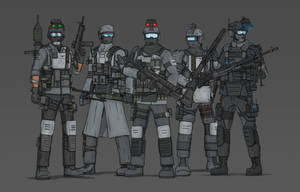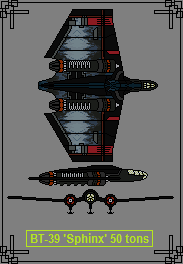ShopDreamUp AI ArtDreamUp
Deviation Actions

Republic Founder
If you want to financially support my personal art and the construction of my sci-fi story, feel free to tip me jsjsjs.
$1/month
Suggested Deviants
Suggested Collections
You Might Like…
Description
BT-39 'Sphinx'
“The reports of strange tailless aircraft that were seen to hover like helicopters persisted years after Vietnam. At first it was thought to be some sort of Soviet MiG but we have our doubts even the soviets could manage this feat. None the less UN and NATO had a fit about stealthy soviet tactical helicopters. We honestly are still a bit baffled as no photographic evidence exists to prove or disprove the phenomenon.”
- CIA report on threats to American Interests circa 2003
“The end of World War Two and the capture of many German aerospace industrial sites yielded reams of data about unusual aircraft design. Prone-pilot designs, wingless models even a few literal flying saucers that used a central turbine were found. The strangest of all were the hovering designs, considered a precursor to modern helicopters any good modern engineer would throw out the consideration and label them hovercraft instead. Foo Fighters however remained baffling as an Axis anti air weapon, allied aircraft were lost to them yet no one knew where these UFO’s came from or how the Axis made them happen.“ – ‘Mysteries of the Post World War Two Era’ by Stanley Cuffington.
Overview
The BT-39 was originally labeled the ‘Sphinx’ by test pilots because of its absolutely confusing operations manual. Many pilots joked that the first manuals were like answering the Mythological Sphinx’s riddle wrong which of course would result in death. Admittedly the entire BT-39 project was plagued with problems that almost saw the project cancelled several times for being over budget and horribly unsafe. Dry research efforts resolved most of the obvious problems while wind tunnel and hydrodynamic testing handled the majority of other issues. The original model’s main issue was the structural instability of having the craft’s engines mounted high on the rear fuselage. The rear configuration made for a terrible center of gravity and poor handling in anything but a calm wind. A later redesign saw the engines improved but moved into the wings which improved the instability but ruined pilot visibility. The engines used were clones of prototype Sikorsky turbofan type jet engines and thus were unusually bulky due to their untested status. The solution was to turn the wing, a critical lift area into an inverted gull wing style while retaining the same shape and putting the engines between the much thicker inward wing root and the outboard lift area. The final change to the design was the inclusion of a high-visibility cockpit that utilized special one-way see-through ‘glass’. The material used in the cockpit windows makes the interior look uninhabited if viewed from outside yet offers the same visibility as plain glass would. Thankfully the composite material is quite rugged and can withstand a few hits. With the changes the BT-39’s nickname persists mostly due to the final configuration. If viewed from a top down perspective the outboard engines and the forward portion of the main body resembled an abstract sphinx in flight.
Overall the appearance of the BT-39 resembles no known hovercraft, instead looking more like a flying-wing type aircraft. This Design is as much to confuse observers into thinking it an aircraft as it is to provide the most efficient platform for the exact performance profile the BT-39 is to undertake.
Capabilities
The sphinx is one of those rare units where every component has been so heavily tested or borrowed from other units that little can go wrong with the final model. By design this unconventional hovercraft is fast moving for its size, hard to detect and very much able to defend itself and it’s landing area from unwanted incursions.
The primary armament of the BT-39 is a standard 15lb legacy gun which is provided a ton of ammunition. Given the size of the craft some might consider the 15lb weapon more of a pop-gun for a combat situation but the fact remains that the BT-39 is more of a reconnaissance unit then a front-line aggressor. Supporting the main armament are twelve heavy machine guns, four of which are crew controlled while the remaining eight are split between the wings in a dead-forward angle under the pilot’s control.
The key to the unit’s stealthy abilities is its shape, as the inverted gull-wing and large gently angled wing area absorbs sensors so it has the sensor signature of a large dragon fly. This sensor-stealth is coupled with the whisper-quiet of the induction engines and the relative speed of the craft.
The only flaw to the sphinx is when it is employed as anything but a reconnaissance unit, as carrying troops means the removal of the primary armament. Fortunately, most sphinx of the cargo type are heavily escorted and supported. Were a crafty enemy to draw off such support serious problems could arise.
Deployment
The BT-39 has seen deployment worldwide, yet the world as a whole has no idea. It is only a matter of time until some local yokel with a digital camera snaps a shot of one.
“The reports of strange tailless aircraft that were seen to hover like helicopters persisted years after Vietnam. At first it was thought to be some sort of Soviet MiG but we have our doubts even the soviets could manage this feat. None the less UN and NATO had a fit about stealthy soviet tactical helicopters. We honestly are still a bit baffled as no photographic evidence exists to prove or disprove the phenomenon.”
- CIA report on threats to American Interests circa 2003
“The end of World War Two and the capture of many German aerospace industrial sites yielded reams of data about unusual aircraft design. Prone-pilot designs, wingless models even a few literal flying saucers that used a central turbine were found. The strangest of all were the hovering designs, considered a precursor to modern helicopters any good modern engineer would throw out the consideration and label them hovercraft instead. Foo Fighters however remained baffling as an Axis anti air weapon, allied aircraft were lost to them yet no one knew where these UFO’s came from or how the Axis made them happen.“ – ‘Mysteries of the Post World War Two Era’ by Stanley Cuffington.
Overview
The BT-39 was originally labeled the ‘Sphinx’ by test pilots because of its absolutely confusing operations manual. Many pilots joked that the first manuals were like answering the Mythological Sphinx’s riddle wrong which of course would result in death. Admittedly the entire BT-39 project was plagued with problems that almost saw the project cancelled several times for being over budget and horribly unsafe. Dry research efforts resolved most of the obvious problems while wind tunnel and hydrodynamic testing handled the majority of other issues. The original model’s main issue was the structural instability of having the craft’s engines mounted high on the rear fuselage. The rear configuration made for a terrible center of gravity and poor handling in anything but a calm wind. A later redesign saw the engines improved but moved into the wings which improved the instability but ruined pilot visibility. The engines used were clones of prototype Sikorsky turbofan type jet engines and thus were unusually bulky due to their untested status. The solution was to turn the wing, a critical lift area into an inverted gull wing style while retaining the same shape and putting the engines between the much thicker inward wing root and the outboard lift area. The final change to the design was the inclusion of a high-visibility cockpit that utilized special one-way see-through ‘glass’. The material used in the cockpit windows makes the interior look uninhabited if viewed from outside yet offers the same visibility as plain glass would. Thankfully the composite material is quite rugged and can withstand a few hits. With the changes the BT-39’s nickname persists mostly due to the final configuration. If viewed from a top down perspective the outboard engines and the forward portion of the main body resembled an abstract sphinx in flight.
Overall the appearance of the BT-39 resembles no known hovercraft, instead looking more like a flying-wing type aircraft. This Design is as much to confuse observers into thinking it an aircraft as it is to provide the most efficient platform for the exact performance profile the BT-39 is to undertake.
Capabilities
The sphinx is one of those rare units where every component has been so heavily tested or borrowed from other units that little can go wrong with the final model. By design this unconventional hovercraft is fast moving for its size, hard to detect and very much able to defend itself and it’s landing area from unwanted incursions.
The primary armament of the BT-39 is a standard 15lb legacy gun which is provided a ton of ammunition. Given the size of the craft some might consider the 15lb weapon more of a pop-gun for a combat situation but the fact remains that the BT-39 is more of a reconnaissance unit then a front-line aggressor. Supporting the main armament are twelve heavy machine guns, four of which are crew controlled while the remaining eight are split between the wings in a dead-forward angle under the pilot’s control.
The key to the unit’s stealthy abilities is its shape, as the inverted gull-wing and large gently angled wing area absorbs sensors so it has the sensor signature of a large dragon fly. This sensor-stealth is coupled with the whisper-quiet of the induction engines and the relative speed of the craft.
The only flaw to the sphinx is when it is employed as anything but a reconnaissance unit, as carrying troops means the removal of the primary armament. Fortunately, most sphinx of the cargo type are heavily escorted and supported. Were a crafty enemy to draw off such support serious problems could arise.
Deployment
The BT-39 has seen deployment worldwide, yet the world as a whole has no idea. It is only a matter of time until some local yokel with a digital camera snaps a shot of one.
Image size
183x264px 8.42 KB
© 2011 - 2024 GratefulReflex
Comments0
Join the community to add your comment. Already a deviant? Log In






















![[DL] Radiance model](https://images-wixmp-ed30a86b8c4ca887773594c2.wixmp.com/i/1feaf5b3-6af7-4a49-bf97-409ec907ff55/d8sv70i-d1b95ad6-da88-4a7a-a387-ac5b5ebd8643.jpg/v1/crop/w_184)

![[DL] Steelhooves V1](https://images-wixmp-ed30a86b8c4ca887773594c2.wixmp.com/i/9c7d942f-76a1-46b0-bba8-c446d127bbbb/d95a10c-35fbaa67-4785-43ec-8fbe-7feee590cf02.png/v1/crop/w_184)
](https://images-wixmp-ed30a86b8c4ca887773594c2.wixmp.com/f/85b9d213-1665-44cf-9000-baad1b907a25/dfneqid-5c1aa06a-9d31-44f2-b31a-97625bd1cdc0.png/v1/crop/w_184)
](https://images-wixmp-ed30a86b8c4ca887773594c2.wixmp.com/f/85b9d213-1665-44cf-9000-baad1b907a25/dfkxitd-9d148992-be3e-476e-abcf-2d2084b3a16b.png/v1/crop/w_184)

](https://images-wixmp-ed30a86b8c4ca887773594c2.wixmp.com/f/85b9d213-1665-44cf-9000-baad1b907a25/dfneqgf-ce41da35-b08a-4658-95bf-80e71c8eab44.png/v1/crop/w_184)



![RPK MK.III [SRU Kit] (WIP V1)](https://images-wixmp-ed30a86b8c4ca887773594c2.wixmp.com/f/85b9d213-1665-44cf-9000-baad1b907a25/dfhfid3-6c86ff13-9817-47f6-817b-cb5a988253cb.png/v1/crop/w_184)
